A Installation and Configuration Screens for Oracle Forms and Reports
This appendix contains a flowchart describing the order in which you would see each installation screen, along with screenshots and descriptions for each of the Oracle Forms and Reports installation and configuration screens.
The following topics are covered:
-
Flowchart of Oracle Forms and Reports Installation and Configuration Screens
-
Descriptions of the Oracle Forms and Reports Installation and Configuration Screens
A.1 Flowchart of Oracle Forms and Reports Installation and Configuration Screens
Figure A-1 shows a flowchart of installation screens and which screens you will see based on the options you select.
Figure A-1 Oracle Forms and Reports Installation and Configuration Screens Flowchart
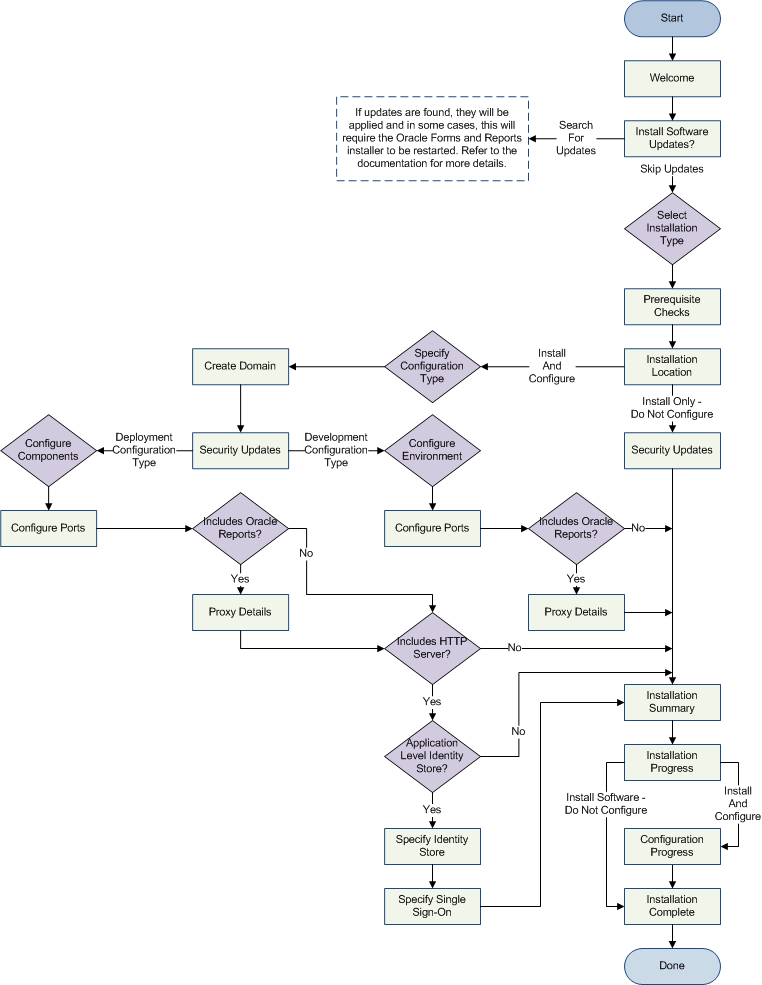
Description of "Figure A-1 Oracle Forms and Reports Installation and Configuration Screens Flowchart"
A.2 Descriptions of the Oracle Forms and Reports Installation and Configuration Screens
This section contains details and descriptions for each of the Oracle Forms and Reports installation and configuration screens:
A.2.1 Specify Inventory Directory
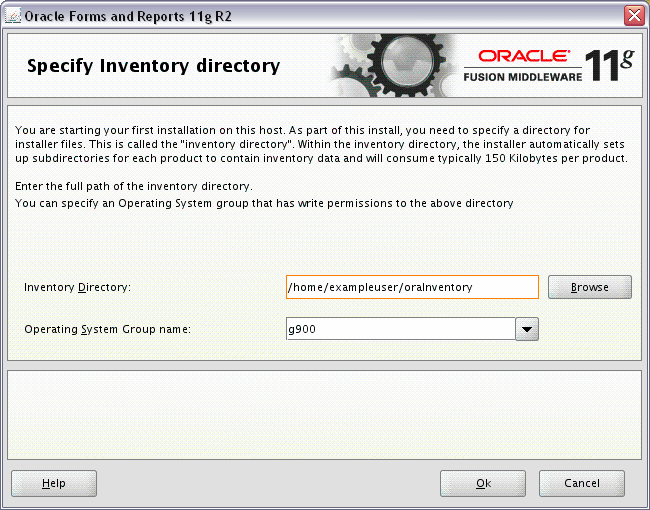
Description of the illustration install_inventory.gif
This screen appears for UNIX systems only; if this is your first Oracle installation on this host, you must specify the location of the inventory directory. This inventory directory is used by the installer to keep track of all Oracle products installed on the computer.
The default inventory location is USER_HOME/oraInventory.
In the Operating System Group name field, select the group whose members you want to grant access to the inventory directory; all members of this group will be able to install products on this machine.
Click OK to continue.
A.2.2 Inventory Location Confirmation
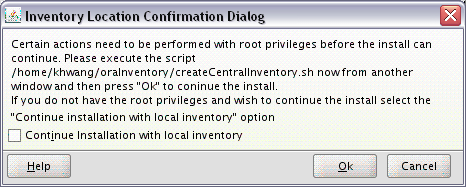
Description of the illustration install_inventory_confirm.gif
This screen appears for UNIX systems only; you are asked to run the inventory_directory/createCentralInventory.sh script as root.
If you do not have root access on this machine but wish to continue with the installation, select Continue installation with local inventory.
Click OK to continue.
A.2.3 Welcome

Description of the illustration welcome.gif
This page introduces you to the Oracle Fusion Middleware installer and provides two important pieces of information:
-
A navigation pane on the left that summarizes the tasks the installer will help you complete. Each item in the navigation pane represents a specific installer screen that will prompt you for information required to install the software.
-
Information about any prerequisites you might need to perform before continuing with the installation.
Review the information on this screen carefully to be sure you have performed all the necessary prerequisites.
If you are not sure about any of the prerequisite tasks, refer to the Oracle Fusion Middleware Installation Planning Guide, as well as the installation guide for the specific Oracle Fusion Middleware software you are about to install.
A.2.4 Software Updates
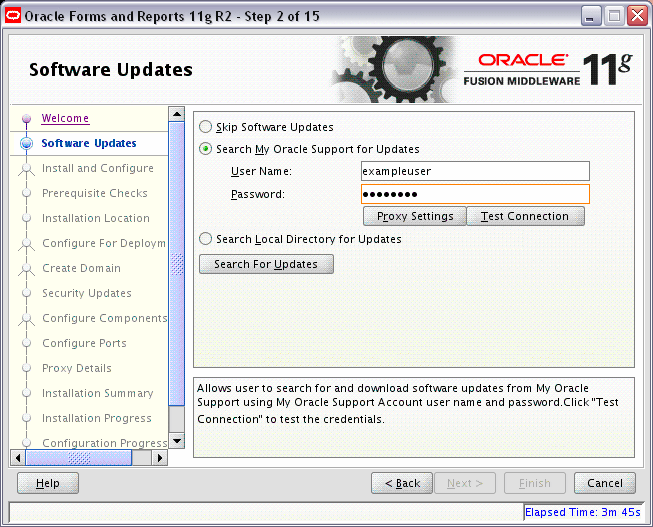
Description of the illustration swupdates_mos.gif
Select the method you want to use for installing software updates.
If you choose to search for updates, the installer will look for updates in the specified location. If any updates are found, the installer will list them on the screen beneath the Search For Updates button.
When you click Next, the installer will automatically apply any updates that are found. In some cases, this will require the installer to be restarted. In such cases, the Software Updates screen will not be displayed again.
A.2.4.1 Skip Software Updates
Select this option if you do not want the installer to check for updates that might be applicable to the current product installation.
A.2.4.2 Search My Oracle Support for Updates
If you have a My Oracle Support account, then select this option to have the installer automatically search My Oracle Support for software updates that apply to the software products are about to install.
Enter your My Oracle Support account name and password, and then click Search For Updates. The installer automatically downloads applicable software updates from My Oracle Support.
Before you search for update, you can test your login credentials and the connection to My Oracle Support by clicking Test Connection. Click Proxy Settings to configure a proxy server if one is required:
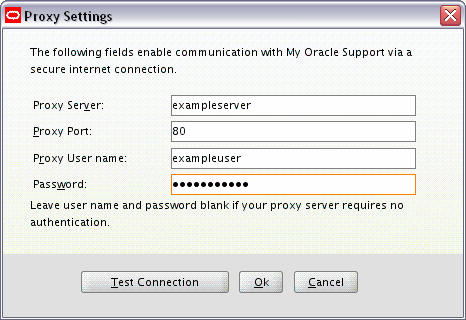
Description of the illustration swupdates_ports.gif
A.2.4.3 Search Local Directory for Updates
Select this option if you already downloaded the latest software updates and you want the installer to search a local directory for updates applicable to the products you are about to install.
When you select this option, the installer displays an additional field and Browse button that you can use to identify the local directory where your updates are located:
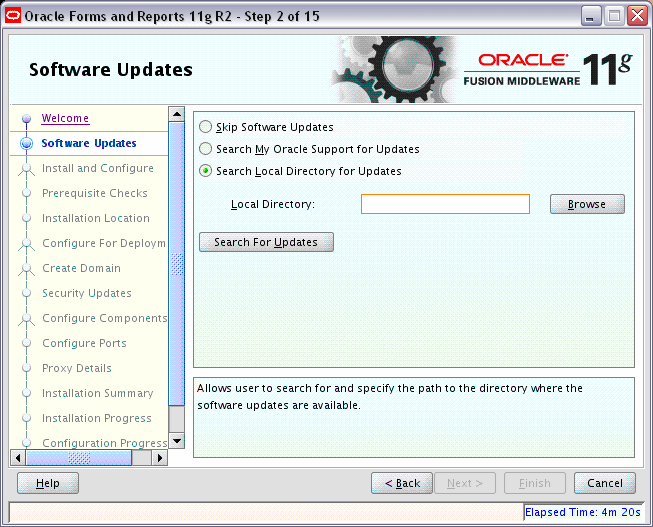
Description of the illustration swupdates_local.gif
A.2.5 Installation Type

Description of the illustration install_type.gif
The following table describes the options on this screen.
| Option | Description |
|---|---|
|
Install and Configure |
Select this option to have the installer create an Oracle home directory where the software will be installed, and an Oracle Instance directory where a working instance of the software will be created. After the installation is complete, you can modify the configured instance using Enterprise Manager or WebLogic Server Administration Console. |
|
Install Software - Do Not Configure |
Select this option to have the installer create an Oracle Home directory where the software will be installed. After the installation, you must run the Configuration Tool separately to configure a working instance. |
A.2.6 Prerequisite Checks
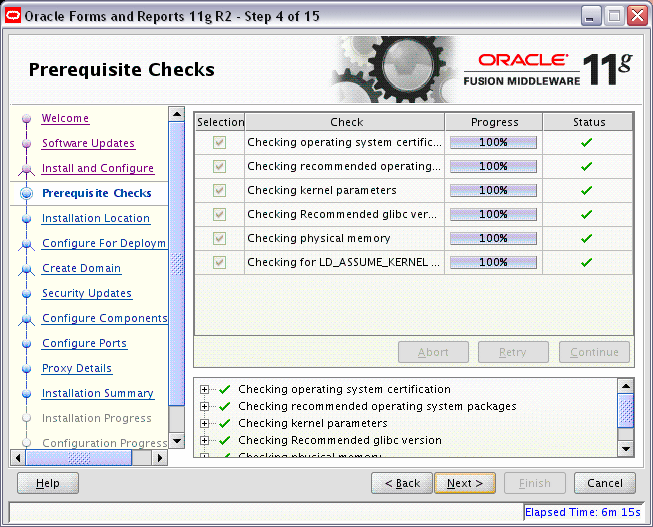
Description of the illustration prereq_checks.gif
This screen analyzes the host computer to ensure that specific operating system prerequisites have been met.
If any of the prerequisite checks fail, then a short error message appears in the bottom portion of the screen. Fix the error and click Retry to try again. If you want to ignore the error or warning messages and continue with the installation, click Continue.
Click Abort to stop prerequisite checking for all components.
More About System Requirements and Prerequisites
Note that before performing any installation you should read the system requirements and certification documentation to ensure that your environment meets the minimum installation requirements for the products you are installing. Both of these documents are available on Oracle Technology Network (OTN).
The Oracle Fusion Middleware System Requirements and Specifications document covers information such as hardware and software requirements, minimum disk space and memory requirements, and required system libraries, packages, or patches.
The Oracle Fusion Middleware certification document for this release can be found on the Oracle Fusion Middleware Supported System Configurations page. This document covers supported installation types, platforms, operating systems, databases, JDKs, and third-party products.
Note:
On Linux and UNIX operating systems, if you are installing the 32-bit version of the product, the system on which you are installing must also be a supported 32-bit system. Installing a 32-bit version of the product on a 64-bit system is not supported.
A.2.7 Installation Location
The contents of this screen differ depending on how you access this screen. There are three possibilities:
-
You selected Install and Configure on the Installation Type.
-
Install Only - Do Not Configure Option
You selected Install Software - Do Not Configure on the Installation Type.
-
You ran the Configuration Tool from the
bindirectory in your Oracle home.
Refer to "Oracle Fusion Middleware Directory Structure and Concepts" in Oracle Fusion Middleware Installation Planning Guide for more information about these directories.
If you are performing an installation on a Windows operating system, be sure that your directory paths are valid and do not contain double backslashes (\\).
A.2.7.1 Install and Configure Option
If you selected the Install and Configure option on the Installation Type screen, the Specify Installation Location screen appears as shown below:

Description of the illustration install_location.gif
The following table describes the fields on this screen:
| Field | Description |
|---|---|
|
Oracle Middleware Home Location |
The absolute path to the directory where WebLogic Server was installed. If you are installing Oracle Reports on a Windows operating system, make sure the path to your Middleware home directory is not too long. For more information, see Section F.3, "Verifying Environment Variable Lengths for Oracle Reports (Windows Only)". |
|
Oracle Home Directory |
The directory name for your Oracle home:
Your Oracle home directory where your products will be installed. All software binaries will reside in this directory, and no runtime process can write to this directory. |
|
WebLogic Server Location |
The directory name for your WebLogic Server home. This directory will automatically be created inside the Middleware home. The default name for this directory is |
|
Oracle Instance Location |
The absolute path to the directory where your Oracle Instance will reside. This is where application configuration files reside and where the application process runs from. Runtime components write only to this location. By default, this directory will be created inside the Middleware home but you can choose any location on your system. |
|
Oracle Instance Name |
Specify the unique name of your Oracle Instance. The Oracle Instance name may only contain alphanumeric and underscore (_) characters, it must begin with an alphabetic (a-z or A-Z) character, and must be 4 to 30 characters in length. |
A.2.7.2 Install Only - Do Not Configure Option
If you selected the Install Software - Do Not Configure option on the Installation Type screen, the Specify Installation Location screen appears as shown below:
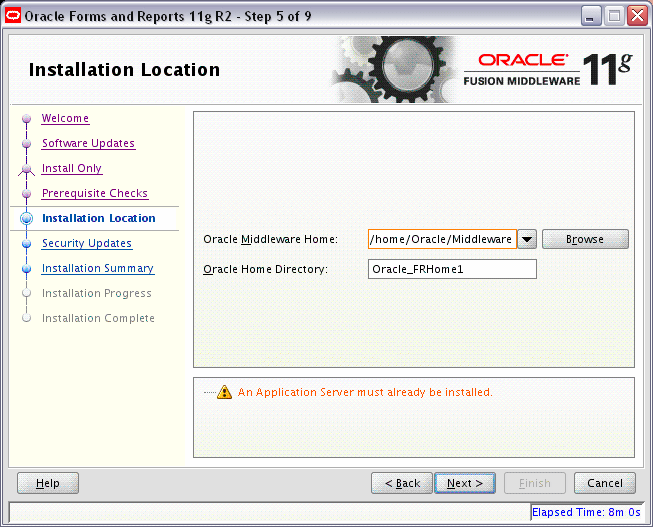
Description of the illustration install_location_install_only.gif
The following table describes the fields on this screen:
| Field | Description |
|---|---|
|
Oracle Middleware Home |
The absolute path to the directory where WebLogic Server was installed. If you are installing Oracle Reports on a Windows operating system, make sure the path to your Middleware home directory is not too long. For more information, see Section F.3, "Verifying Environment Variable Lengths for Oracle Reports (Windows Only)". |
|
Oracle Home Directory |
The directory name for your Oracle home:
Your Oracle home directory where your products will be installed. All software binaries will reside in this directory, and no runtime process can write to this directory. |
A.2.7.3 Configuration Tool Option
If you ran the Configuration Tool from the bin directory inside your Oracle home, the Specify Installation Location screen appears as shown below:
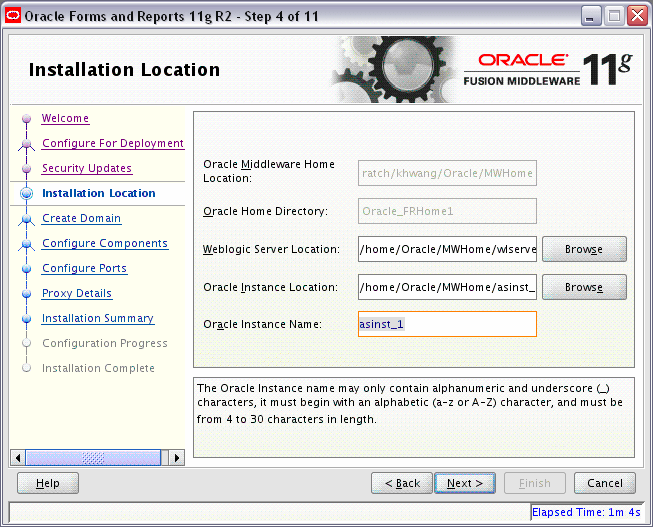
Description of the illustration install_location_config_only.gif
The following table describes the fields on this screen:
| Field | Description |
|---|---|
|
WebLogic Server Location |
The directory name for your WebLogic Server home. This directory will automatically be created inside the Middleware home. The default name for this directory is |
|
Oracle Instance Location |
The absolute path to the directory where your Oracle Instance will reside. This is where application configuration files reside and where the application process runs from. Runtime components write only to this location. By default, this directory will be created inside the Middleware home but you can choose any location on your system. |
|
Oracle Instance Name |
Specify the unique name of your Oracle Instance. The Oracle Instance name may only contain alphanumeric and underscore (_) characters, it must begin with an alphabetic (a-z or A-Z) character, and must be 4 to 30 characters in length. |
A.2.8 Configuration Type
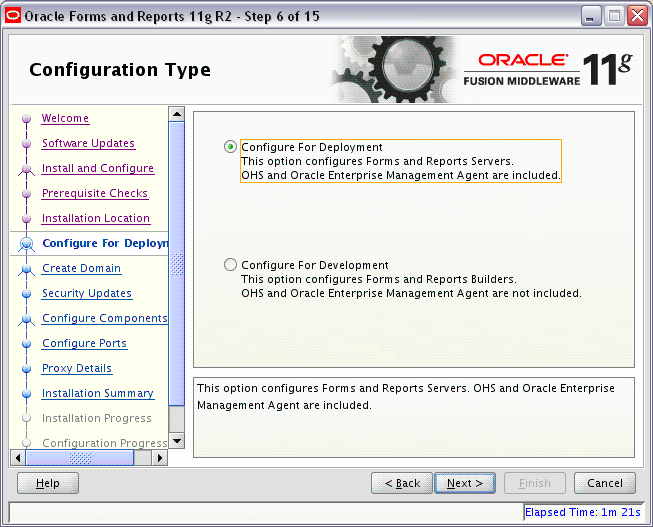
Description of the illustration specify_config_type.gif
Specify the configuration type you want to use for your installation.
The following table describes the options on this screen.
| Option | Description |
|---|---|
|
Configure For Deployment |
Select this option to install and configure Oracle Forms and Reports. Oracle HTTP Server and Oracle Enterprise Manager are included. |
|
Configure For Development |
Select this option to install and configure Oracle Forms and Reports. Oracle HTTP Server and Oracle Enterprise Manager are not included. NOTE: This option is not supported for use as a production application environment. |
A.2.9 Select Domain
Use this screen to create a new WebLogic domain, extend an existing domain, or expand a cluster. For more information about these concepts, refer to the Oracle Fusion Middleware Installation Planning Guide.
Select the method you want to use to associate your components with a WebLogic Server domain:
Note:
If you are planning to extend your domain or expand your cluster, you must choose the Configure For Deployment option on the Configuration Type screen.
A.2.9.1 Create Domain
Select Create Domain to create a new WebLogic Server domain.
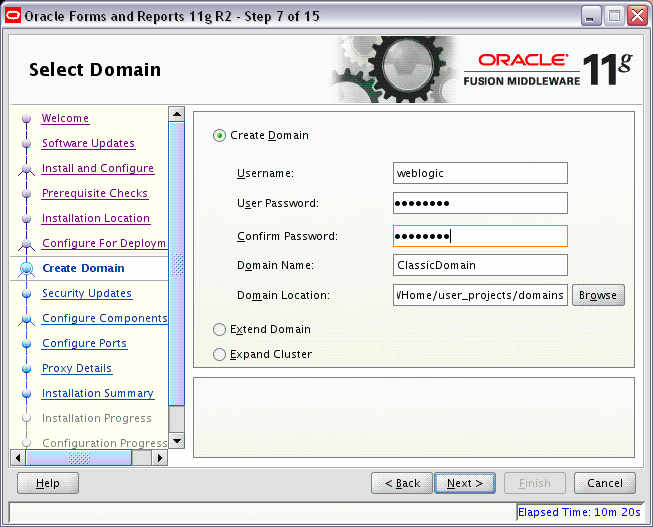
Description of the illustration select_domain_create.gif
The following table describes the fields on this screen:
| Field | Description |
|---|---|
|
User Name |
Specify the user name. The default user name is |
|
User Password |
Specify the user password. Valid passwords are 8 to 30 characters long, must begin with an alphabetic character, use only alphanumeric, underscore (_), dollar ($) or pound (#) characters. It should contain at least one numeric, underscore (_), dollar ($), or pound (#) character. |
|
Confirm Password |
Re-enter the user password. |
|
Domain Name |
Specify the name of the domain you want to create. Domain names may only contain alphanumeric characters, or the underscore (_) or hyphen (-) characters. |
|
Domain Location |
Specify the location where you want to create your new domain. If you do not specify a location, the domain will be created in the following location: On UNIX operating systems: MW_HOME/user_projects/domains/domain_name On Windows operating systems: MW_HOME\user_projects\domains\domain_name For more information about the domain location (also known as the Domain home), see "WebLogic Server Domain" in the Oracle Fusion Middleware Installation Planning Guide. |
A.2.9.2 Extend Domain
If an existing domain is detected, you will have the option of extending the existing domain to add the products and services you are installing.
Note:
You can only extend a domain that was created by the Oracle Forms and Reports installer for this release (11g Release 2 - 11.1.2).

Description of the illustration select_domain_extend.gif
The following table describes the fields on this screen:
| Field | Description |
|---|---|
|
Host Name |
Specify the name of the system where the domain is located. |
|
Port |
Specify the port number on the host where the domain can be accessed. |
|
User Name |
Specify the user name. The default user name is |
|
User Password |
Specify the password for the user. |
A.2.9.3 Expand Cluster
You can also choose Expand Cluster to add Managed Servers for high availability and replication.
Note:
You can only expand a cluster that was created by the Oracle Forms and Reports installer for this release (11g Release 2 - 11.1.2).
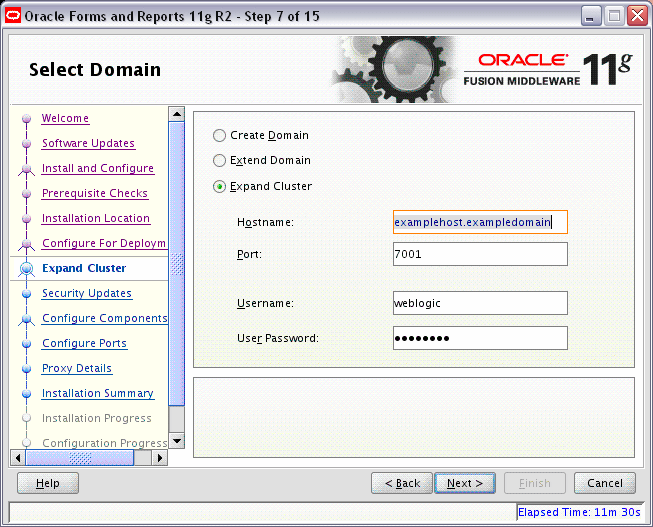
Description of the illustration select_domain_expand.gif
The following table describes the fields on this screen:
| Field | Description |
|---|---|
|
Host Name |
Specify the name of the system where the cluster is located. |
|
Port |
Specify the port number on the host where the cluster can be accessed. |
|
User Name |
Specify the user name. The default user name is |
|
User Password |
Specify the password for the user. |
A.2.10 Security Updates
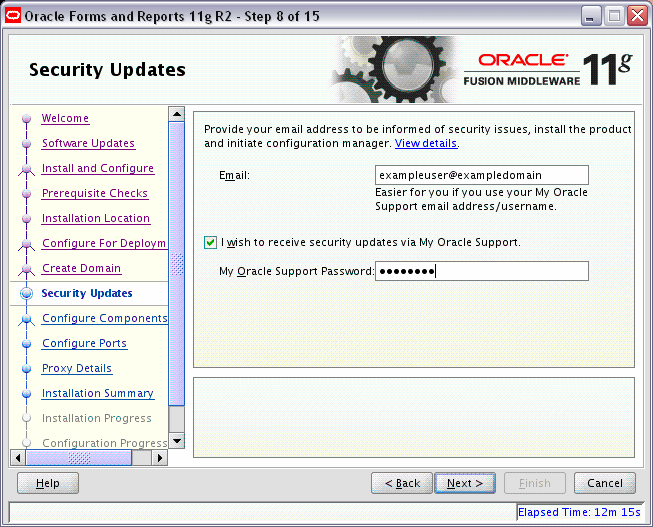
Description of the illustration specify_security_updates.gif
Use this screen to enter your My Oracle Support account information so you can receive the latest product information and security updates via your My Oracle Support account.
Enter your E-mail address if you want to receive the latest product information and security updates. If you have a My Oracle account and wish to receive updates via this mechanism, select I wish to receive security updates via My Oracle Support, then enter your account password.
If you do not wish to register for Oracle Configuration Manager, uncheck the I wish to receive security updates via My Oracle Support box and leave all the fields on this screen blank. You will be prompted to confirm your selection with the following screen:
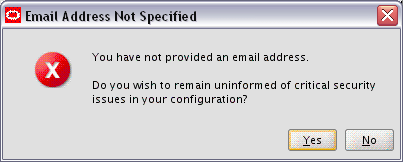
Description of the illustration confirm_no_security_updates.gif
Click Yes to confirm that you do not want to register for security updates.
A.2.11 Configure Components

Description of the illustration configure_components.gif
This screen shows the products and components that are available for configuration. What appears on this screen depends on what you selected on the Configuration Type and Select Domain screens.
On the Configuration Type screen:
| Option | Description |
|---|---|
|
If you selected Configure for Deployment: |
All Oracle Forms and Reports components, in addition to Oracle HTTP Server and Oracle Enterprise Manager, are available. |
|
If you selected Configure for Development: |
All Oracle Forms and Reports components are available, but Oracle HTTP Server and Oracle Enterprise Manager, are not available. |
On the Select Domain screen:
| Option | Description |
|---|---|
|
If you selected Create Domain: |
All available components will appear on this screen. |
|
If you selected Extend Domain: |
Only those components that do not already exist in the domain will be available on this screen, in order for you to add functionality and services to your existing domain. |
|
If you selected Expand Cluster: |
Only those components that already exist in the domain will be available on this screen, in order for you to perform your replication for high availability. |
Notice in the bottom pane that there is prerequisite information depending on which component(s) you select. Be sure you read this information carefully before you continue.
Oracle recommends selecting Clustered for all installations; if you do not and the installation is completed, you will not be able to expand your domain. Any servers created in an un-clustered environment will not have the ability to be managed from Oracle Enterprise Manager.
A.2.12 Configure Ports

Description of the illustration configure_ports.gif
Select Auto Port Configuration if you want the installer to automatically assign the default ports to the components. For a list of default port numbers, see "Port Numbers" in the Oracle Fusion Middleware Administrator's Guide.
Select Specify Ports Using Configuration File if you have already created a port configuration file that specifies the port numbers that you want to use for each component. Enter the full part and filename of this file in the Filename field, or click Browse to locate an existing file on your system.
A default file called staticports.ini is provided in the Disk1/stage/Response directory. You can use this file as a template to create your own custom ports file.
Note:
If you choose to use the staticports.ini (or any custom port file), port numbers less than 1024 will not be validated by the installer. You will, however, be able to proceed with the installation.
See "Port Numbers" in Oracle Fusion Middleware Administrator's Guide for more information.
After providing the location and name of a valid file, click View/Edit File to view or edit the contents of the file.
A.2.13 Proxy Details
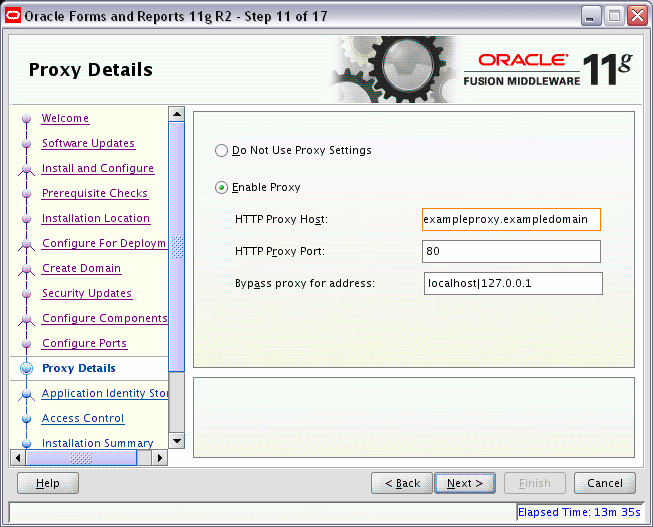
Description of the illustration specify_proxy_details.gif
If your computer is located behind a firewall you may need to route outgoing HTTP connections through a proxy server. If you have a direct connection to the Internet or if you do not wish to configure a proxy server at this time, select Do Not Use Proxy Settings.
If you are configuring a proxy server, select Enable Proxy and provide the information described in the following table:
| Field Name | Description |
|---|---|
|
HTTP Proxy Host |
Enter the host name of your proxy server. |
|
HTTP Proxy Port |
Enter the port number of your proxy server. |
|
Bypass proxy for address |
Enter addresses for which the proxy server should be bypassed. Use commas (,) to separate multiple entries. Domains may be listed using asterisk (*). For example: *.example1.com,*.example2.com |
A.2.14 Application Identity Store
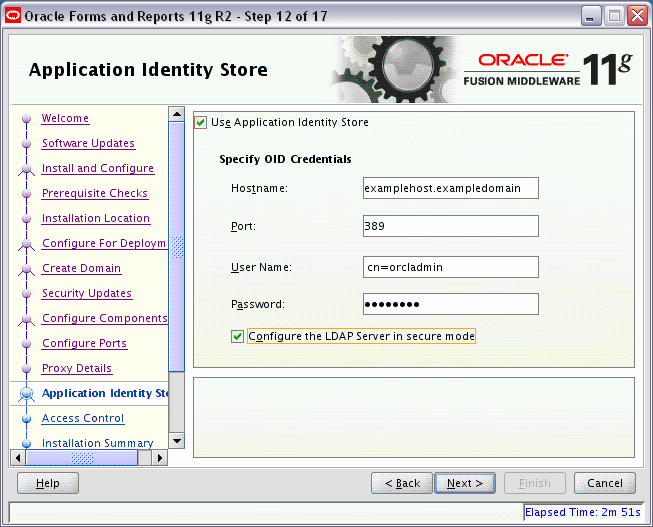
Description of the illustration specify_identity_store.gif
Select Use Application Identity Store to configure your components for use with an Oracle Internet Directory server.
The following table describes the fields on this page.
| Field | Description |
|---|---|
|
Hostname |
Enter the host name of your Oracle Internet Directory server. |
|
Port |
Enter the port number of your Oracle Internet Directory server. If you do not know the port number, you can run the |
|
User Name |
Enter an existing Oracle Internet Directory user name with superuser privileges. The default user name is |
|
Password |
Enter the Oracle Internet Directory user password. |
Select Configure the LDAP Server in secure mode to configure the LDAP server in secure mode. Be sure to specify the secure port number in the Port field if you select this option.
A.2.15 Access Control
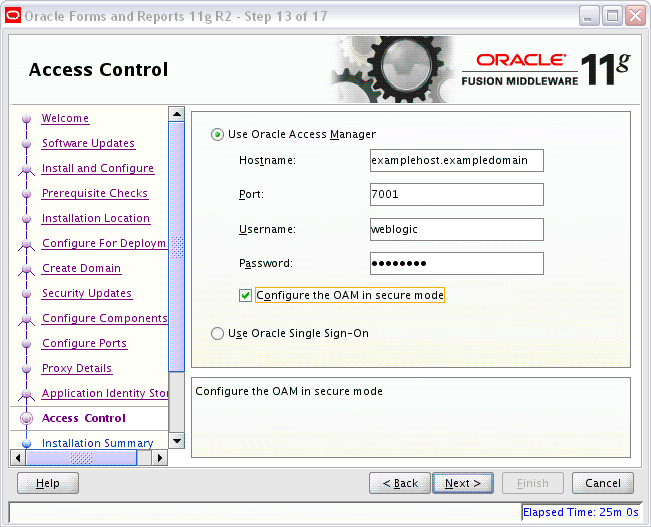
Description of the illustration access_control.gif
Select Use Oracle Access Manager to configure Oracle Access Manager as the tool to perform authentication. The following table describes the fields you will need to complete to use Oracle Access Manager:
| Field | Description |
|---|---|
|
Hostname |
Enter the host name where your Oracle Access Manager Administration Server is running. |
|
Port |
Enter the port number of your Oracle Access Manager Administration Server. |
|
User Name |
Enter the Oracle Access Manager Administrator user name. |
|
Password |
Enter the Oracle Access Manager Administrator user password. |
|
Configure the OAM in secure mode |
Select this checkbox if you want to configure your Oracle Access Manager in secure mode. Be sure to specify the secure port number for your Oracle Access Manager server in the Port field. |
Select Use Oracle Single Sign-On to configure your existing Oracle Single Sign-On as the tool to perform authentication. If you select this option, you will not need to fill out any additional credentials as the Oracle Internet Directory credentials provided on the Application Identity Store screen will be used.
A.2.16 Installation Summary

Description of the illustration install_summary.gif
This screen summarizes the selections you have made during this installation session. It includes the following information:
-
The location of your installation.
-
How much disk space will be used for the installation.
-
The applications you have selected for installation.
Review information on this screen carefully, and take one of the following actions:
-
If you want to make any changes to the configuration before starting the installation, use the navigation pane to select the Installer screen you want to return to and edit.
-
If you are satisfied with the information, click Install to begin the installation procedure.
-
If you want to save this configuration to a text file (called a response file), click Save. The resulting response file can be used later if you choose to perform the same installation from the command line.
For more information about silent installation, see Appendix C, "Silent Installation and Deinstallation for Oracle Forms and Reports".
A.2.17 Installation Progress
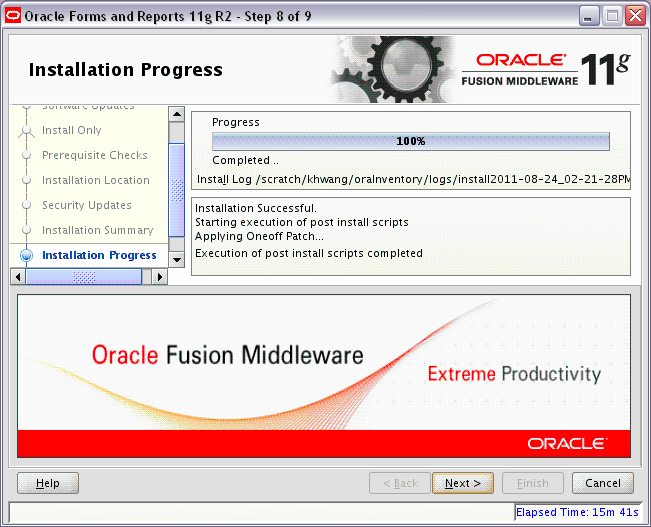
Description of the illustration install_progress.gif
This screen shows you the progress of the installation.
If you are installing on a UNIX system, you may be asked to run the ORACLE_HOME/oracleRoot.sh script as root user before the installation is completed:
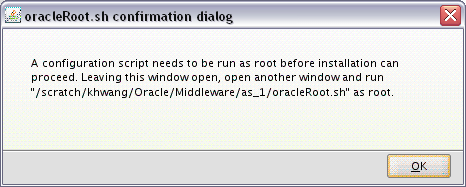
Description of the illustration install_oracleroot_script.gif
This script sets up the proper permissions for the files and directories being installed.
If you want to quit before the installation is completed, click Cancel. Doing so will result in a partial installation; the portion of the software that was installed on your system before you click Cancel will remain on your system, and you will have to remove it manually.
A.2.18 Configuration Progress
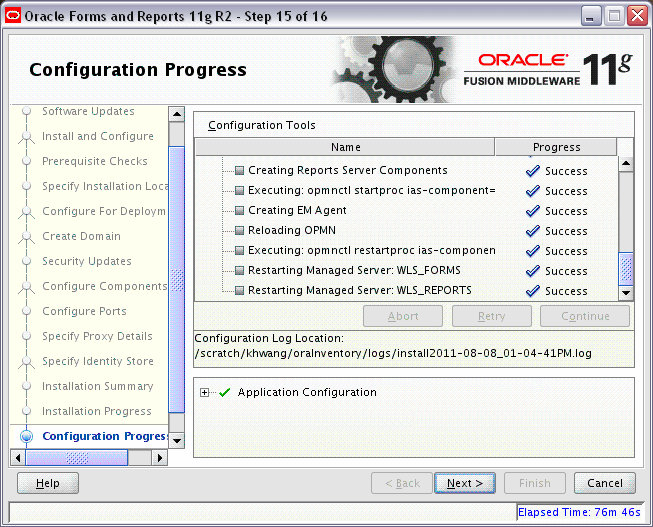
Description of the illustration config_progress.gif
This screen shows you the progress of the component configuration.
If there is a problem, a short error message appears in the bottom portion of the screen. Fix the error and click Retry to try again.
If you want to ignore the error and warning messages and continue with the installation, click Continue.
Click Abort to stop prerequisite checking for all components.
If you want to quit before the installation is completed, click Cancel.
A.2.19 Installation Complete
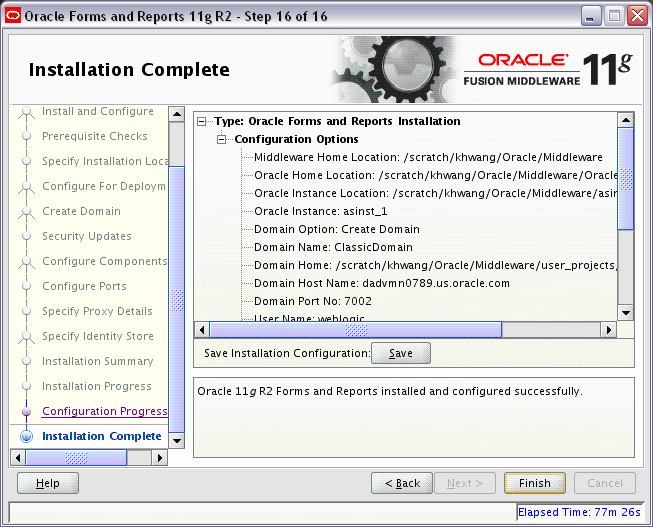
Description of the illustration install_completed.gif
This screen summarizes the installation that was just completed.
The end of the summary information on this screen contains the various URLs to access the Administration Console as well as your installed products. You should write these URLs down so you can access your products later.
Note:
This summary information does not appear on the Installation Complete screen if you chose Install Software - Do Not Configure on the Installation Type screen.
Or, you can click Save to save your configuration information to a file. This information includes port numbers, installation directories, disk space usage, URLs, and component names which you may need at a later time.
Click Finish to dismiss the screen.